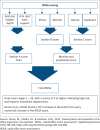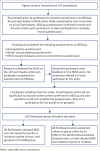Time to re-think our strategy with musculoskeletal disorders and workstation ergonomics
- PMID: 33604477
- PMCID: PMC7876947
- DOI: 10.4102/sajp.v77i1.1490
Time to re-think our strategy with musculoskeletal disorders and workstation ergonomics
Abstract
Background: The dramatic increase in visual display units (VDU) in the workplace over a 20-year period is linked to the increased prevalence of musculoskeletal disorders (MSDs).
Objectives: The objective of our study was to compare ergonomic risk factors and work-related psychosocial factors in VDU users with and without MSD.
Methods: Participants, with and without MSD, working with VDU for more than 4 h a day completed the Nordic Musculoskeletal Questionnaire and the Effort-Reward Imbalance Model and Over-commitment Questionnaire. The workstation of each participant was assessed for ergonomic risk factors using the Rapid Office Strain Assessment (ROSA).
Results: Sixty-eight VDU users with and 68 without MSDs participated. The workstation ergonomic risk factors as measured with the ROSA were similar for the two groups: 4.5 ± 1.0 for the MSD group and 4.3 ± 0.8 for the reference group (p = 0.10). The work-related psychosocial factors, namely over-commitment, were higher in the MSD group (14.9 ± 3.1) than in the reference group (13.8 ± 3.4; p = 0.041).
Conclusions: As over-commitment is an indication of intrinsic factors and personal characteristics, the significant difference between the MSD group's over-commitment score and that of the reference group suggests that interventions to empower individuals are needed.
Clinical implications: Physiotherapists should only adjust ergonomic workstation risk factors when established as contributory to MSD, and should be cognisant of work-related or individual psychosocial factors that may impact the patient with MSD. The use of ergonomic advice to patients with MSD should be performed with caution, taking all the work place risk factors for MSD into account.
Keywords: ROSA; effort-reward imbalance; ergonomics; musculoskeletal disorders; psychosocial factors; visual-display-unit users.
© 2021. The Authors.
Conflict of interest statement
The authors have declared that no competing interest exists.
Figures
Similar articles
-
Differences in ergonomic and workstation factors between computer office workers with and without reported musculoskeletal pain.Work. 2017;57(4):563-572. doi: 10.3233/WOR-172582. Work. 2017. PMID: 28826196
-
Work with visual display units and musculoskeletal disorders: A cross-sectional study.Med Pr. 2016 Dec 22;67(6):707-719. doi: 10.13075/mp.5893.00471. Epub 2016 Dec 1. Med Pr. 2016. PMID: 28005080 English.
-
Work-related Musculoskeletal Disorders in Iranian Office Workers: Prevalence and Risk Factors.J Med Life. 2018 Oct-Dec;11(4):328-333. doi: 10.25122/jml-2018-0054. J Med Life. 2018. PMID: 30894890 Free PMC article.
-
The safe use of visual display units.Singapore Med J. 1994 Aug;35(4):381-5. Singapore Med J. 1994. PMID: 7899897 Review.
-
What do the different ergonomic interventions accomplish in the workplace? A systematic review.Int J Occup Saf Ergon. 2022 Mar;28(1):600-624. doi: 10.1080/10803548.2020.1811521. Epub 2020 Sep 12. Int J Occup Saf Ergon. 2022. PMID: 32799768
Cited by
-
Assessment of Forward Head Posture and Ergonomics in Young IT Professionals - Reasons to Worry?Med Lav. 2023 Feb 14;114(1):e2023006. doi: 10.23749/mdl.v114i1.13600. Med Lav. 2023. PMID: 36790407 Free PMC article.
-
Effort-Reward Imbalance and Its Association with Musculoskeletal Pain among Information Technology Professionals.Indian J Occup Environ Med. 2024 Oct-Dec;28(4):288-292. doi: 10.4103/ijoem.ijoem_135_23. Epub 2024 Dec 23. Indian J Occup Environ Med. 2024. PMID: 39877278 Free PMC article.
References
-
- Celik, S., Celik, K., Dirimese, E., Tasdemir, N., Arik, T. & Buyukkara, I, 2018, ‘Determination of pain in musculoskeletal system reported by office workers and the pain risk factors’, International Journal of Occupational Medicine and Environmental Health 31(1), 91–111. 10.13075/ijomeh.1896.00901 - DOI - PubMed
LinkOut - more resources
Full Text Sources
Other Literature Sources
Research Materials


